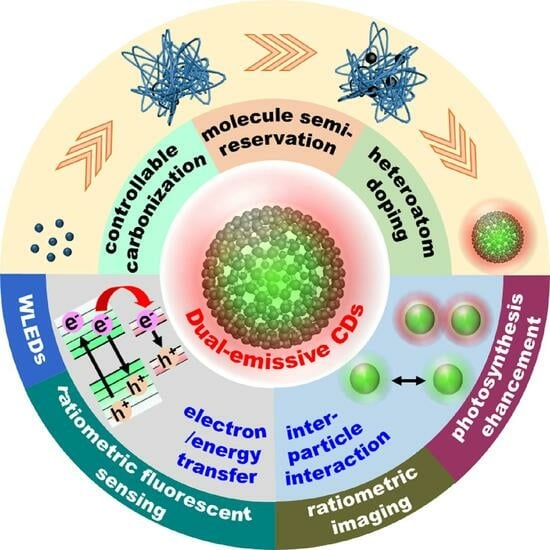Synthesis Strategies, Optical Mechanisms, and Applications of Dual-Emissive Carbon Dots
Abstract
:1. Introduction
2. Synthesis Strategies for Dual-Emissive CDs
2.1. Controllable Carbonization
2.2. Semi-Reservation of Precursor Structure
2.3. Heteroatom Doping Effect
3. Optical Mechanisms of the Dual-Emissive CDs
3.1. Electron Transfer
3.2. Energy Transfer
3.3. Other Mechanisms
4. Applications for the Dual-Emissive CDs
4.1. Constructions of Single-Component WLEDs
4.2. Ratiometric Fluorescent Sensing
4.3. Ratiometric Fluorescent Imaging
4.4. Other Applications
5. Conclusions and Prospects
Funding
Institutional Review Board Statement
Informed Consent Statement
Data Availability Statement
Conflicts of Interest
References
- Chen, J.W.; Xiang, H.Y.; Wang, J.; Wang, R.; Li, Y.; Shan, Q.S.; Xu, X.B.; Dong, Y.H.; Wei, C.T.; Zeng, H.B. Perovskite White Light Emitting Diodes: Progress, Challenges, and Opportunities. ACS Nano 2021, 15, 17150–17174. [Google Scholar] [CrossRef] [PubMed]
- Kang, Y.Y.; Li, D.N.; Dong, R.Y.; Zhang, H.R.; Li, W.; Zhang, X.J.; Yang, X.; Lei, B.F. Multicolor carbon dots assembled polyvinyl alcohol with enhanced emission for white light-emitting diode. J. Lumin. 2022, 251, 119164. [Google Scholar] [CrossRef]
- Wang, Z.Y.; Wang, Z.; Lin, B.J.; Hu, X.F.; Wei, Y.F.; Zhang, C.K.; An, B.; Wang, C.; Lin, W.B. Warm-White-Light-Emitting Diode Based on a Dye-Loaded Metal-Organic Framework for Fast White-Light Communication. ACS Appl. Mater. Interfaces 2017, 9, 35253–35259. [Google Scholar] [CrossRef] [PubMed]
- Wei, J.X.; Hu, Z.; Zhou, W.J.; Lu, H.X.; Zhang, W.L.; Guo, R.Q. Color-converted white light-emitting diodes based on I-III-VI quantum dots: Package strategies and stability promotion. Appl. Mater. Today 2022, 29, 101585. [Google Scholar] [CrossRef]
- Zhang, T.Y.; Zhao, F.F.; Li, L.; Qi, B.; Zhu, D.X.; Lu, J.H.; Lu, C.L. Tricolor White-Light-Emitting Carbon Dots with Multiple-Cores@Shell Structure for WLED Application. ACS Appl. Mater. Interfaces 2018, 10, 19796–19805. [Google Scholar] [CrossRef] [PubMed]
- Han, Y.; Yang, W.X.; Luo, X.L.; He, X.; Zhao, H.P.; Tang, W.Z.; Yue, T.L.; Li, Z.H. Carbon dots based ratiometric fluorescent sensing platform for food safety. Crit. Rev. Food Sci. 2022, 62, 244–260. [Google Scholar] [CrossRef] [PubMed]
- Pei, X.Y.; Pan, Y.; Zhang, L.C.; Lv, Y. Recent advances in ratiometric luminescence sensors. Appl. Spectrosc. Rev. 2021, 56, 324–345. [Google Scholar] [CrossRef]
- Gui, R.J.; Jin, H.; Bu, X.N.; Fu, Y.X.; Wang, Z.H.; Liu, Q.Y. Recent advances in dual-emission ratiometric fluorescence probes for chemo/biosensing and bioimaging of biomarkers. Coord. Chem. Rev. 2019, 383, 82–103. [Google Scholar] [CrossRef]
- Kong, M.F.; Zhan, Y.H.; Yang, T.; Wang, S.Q.; Guo, X.D.; Hu, R.; Qian, Y.; Fan, Q.L.; Yang, G.Q. Single-Sample Ratiometric Organic Films for Naked-Eye High-Temperature Multi-Threshold Indication. Adv. Opt. Mater. 2022, 10, 2101350. [Google Scholar] [CrossRef]
- Liu, Y.Q.; Hu, X.Y.; Liang, F.Y.; Cao, Y.J. A FRET sensor based on quantum dots-porphyrin assembly for Fe(III) detection with ultra-sensitivity and accuracy. Anal. Bioanal. Chem. 2022, 414, 7741–7751. [Google Scholar] [CrossRef]
- Li, S.H.; Ma, Q.P.; Wang, C.L.; Yang, K.D.; Hong, Z.Z.; Chen, Q.S.; Song, J.B.; Song, X.R.; Yang, H.H. Near-Infrared II Gold Nanocluster Assemblies with Improved Luminescence and Biofate for In Vivo Ratiometric Imaging of H2S. Anal. Chem. 2022, 94, 2641–2647. [Google Scholar] [CrossRef]
- Wang, X.B.; Li, C.Y.; Li, Z.Y.; Ma, X.; Chen, D.K.; Wan, X.Y.; Deng, Z.; Deng, R.R.; Peng, X.S. Near-Infrared-Light emitting diode driven white light Emission: Upconversion nanoparticles decorated Metal-Organic Frame-works thin film. Chem. Eng. J. 2021, 409, 128220. [Google Scholar] [CrossRef]
- Xie, R.G.; Peng, X.G. Synthesis of Cu-Doped InP Nanocrystals (d-dots) with ZnSe Diffusion Barrier as Efficient and Color-Tunable NIR Emitters. J. Am. Chem. Soc. 2009, 131, 10645–10651. [Google Scholar] [CrossRef] [PubMed]
- Zhang, Z.L.; Luan, S.Y.; Huang, K.K.; Zhang, Y.; Shi, Z.; Xie, R.G.; Yang, W.S. Single-phase dual emissive Cu:CdS-ZnSe core-shell nanocrystals with “zero self-absorption” and their application in white light emitting diodes. J. Mater. Chem. C 2015, 3, 3614–3622. [Google Scholar] [CrossRef]
- Peng, L.C.; Li, D.Z.; Zhang, Z.L.; Huang, K.K.; Zhang, Y.; Shi, Z.; Xie, R.G.; Yang, W.S. Large-scale synthesis of single-source, thermally stable, and dual-emissive Mn-doped Zn-Cu-In-S nanocrystals for bright white light-emitting diodes. Nano Res. 2015, 8, 3316–3331. [Google Scholar] [CrossRef]
- Zhang, K.; Yu, T.; Liu, F.; Sun, M.T.; Yu, H.; Liu, B.H.; Zhang, Z.P.; Jiang, H.; Wang, S.H. Selective Fluorescence Turn-On and Ratiometric Detection of Organophosphate Using Dual-Emitting Mn-Doped ZnS Nanocrystal Probe. Anal. Chem. 2014, 86, 11727–11733. [Google Scholar] [CrossRef] [PubMed]
- Wang, Y.B.; Yang, M.; Ren, Y.K.; Fan, J. Cu-Mn codoped ZnS quantum dots-based ratiometric fluorescent sensor for folic acid. Anal. Chim. Acta 2018, 1040, 136–142. [Google Scholar] [CrossRef] [PubMed]
- He, L.F.; Bao, Z.J.; Zhang, K.; Yang, D.T.; Sheng, B.B.; Huang, R.; Zhao, T.; Liang, X.C.; Yang, X.J.; Yang, A.N.; et al. Ratiometric determination of copper(II) using dually emitting Mn(II)-doped ZnS quantum dots as a fluorescent probe. Microchim. Acta 2018, 185, 511. [Google Scholar] [CrossRef] [PubMed]
- Zhang, F.M.; Liu, Y.B.; Ma, P.Y.; Tao, S.; Sun, Y.; Wang, X.H.; Song, D.Q. A Mn-doped ZnS quantum dots-based ratiometric fluorescence probe for lead ion detection and “off-on” strategy for methyl parathion detection. Talanta 2019, 204, 13–19. [Google Scholar] [CrossRef]
- Pratiwi, F.W.; Hsia, C.H.; Kuo, C.W.; Yang, S.M.; Hwu, Y.K.; Chen, P.L. Construction of single fluorophore ratiometric pH sensors using dual-emission Mn2+-doped quantum dots. Biosens. Bioelectron. 2016, 84, 133–140. [Google Scholar] [CrossRef]
- Mao, G.B.; Wu, G.Q.; Chen, M.H.; Yan, C.; Tang, J.Y.; Ma, Y.X.; Zhang, X.E. Synthesis of Dual-Emitting CdZnSe/Mn:ZnS Quantum Dots for Sensing the pH Change in Live Cells. Anal. Chem. 2022, 94, 6665–6671. [Google Scholar] [CrossRef] [PubMed]
- Wareing, T.C.; Gentile, P.; Phan, A.N. Biomass-Based Carbon Dots: Current Development and Future Perspectives. ACS Nano 2021, 15, 15471–15501. [Google Scholar] [CrossRef] [PubMed]
- Wang, B.Y.; Lu, S.Y. The light of carbon dots: From mechanism to applications. Matter 2022, 5, 110–149. [Google Scholar] [CrossRef]
- Xu, X.Y.; Ray, R.; Gu, Y.L.; Ploehn, H.J.; Gearheart, L.; Raker, K.; Scrivens, W.A. Electrophoretic analysis and purification of fluorescent single-walled carbon nanotube fragments. J. Am. Chem. Soc. 2004, 126, 12736–12737. [Google Scholar] [CrossRef]
- Dey, S.; Govindaraj, A.; Biswas, K.; Rao, C.N.R. Luminescence properties of boron and nitrogen doped graphene quantum dots prepared from arc-discharge-generated doped graphene samples. Chem. Phys. Lett. 2014, 595, 203–208. [Google Scholar] [CrossRef]
- Calabro, R.L.; Yang, D.S.; Kim, D.Y. Liquid-phase laser ablation synthesis of graphene quantum dots from carbon nano-onions: Comparison with chemical oxidation. J. Colloid Interface Sci. 2018, 527, 132–140. [Google Scholar] [CrossRef]
- Doring, A.; Xiong, Y.; Li, Y.X.; Schneider, J.; Cherevkov, S.A.; Ushakova, E.V.; Rogach, A.L. Composite Nanospheres Comprising Luminescent Carbon Dots Incorporated into a Polyhedral Oligomeric Silsesquioxane Matrix. J. Phys. Chem. C 2021, 125, 15094–15102. [Google Scholar] [CrossRef]
- Jiao, X.Y.; Li, L.S.; Qin, S.; Zhang, Y.; Huang, K.; Xu, L. The synthesis of fluorescent carbon dots from mango peel and their multiple applications. Colloid. Surf. A 2019, 577, 306–314. [Google Scholar] [CrossRef]
- Wang, B.Y.; Li, J.; Tang, Z.Y.; Yang, B.; Lu, S.Y. Near-infrared emissive carbon dots with 33.96% emission in aqueous solution for cellular sensing and light-emitting diodes. Sci. Bull. 2019, 64, 1285–1292. [Google Scholar] [CrossRef]
- de Medeiros, T.V.; Manioudakis, J.; Noun, F.; Macairan, J.R.; Victoria, F.; Naccache, R. Microwave-assisted synthesis of carbon dots and their applications. J. Mater. Chem. C 2019, 7, 7175–7195. [Google Scholar] [CrossRef]
- Li, J.R.; Gong, X. The Emerging Development of Multicolor Carbon Dots. Small 2022, 18, 2205099. [Google Scholar] [CrossRef] [PubMed]
- Yan, F.Y.; Sun, Z.H.; Zhang, H.; Sun, X.D.; Jiang, Y.X.; Bai, Z.J. The fluorescence mechanismof carbon dots, and methods for tuning their emission color: A review. Microchim. Acta 2019, 186, 583. [Google Scholar] [CrossRef] [PubMed]
- Yuan, F.L.; Yuan, T.; Sui, L.Z.; Wang, Z.B.; Xi, Z.F.; Li, Y.C.; Li, X.H.; Fan, L.Z.; Tan, Z.A.; Chen, A.M.; et al. Engineering triangular carbon quantum dots with unprecedented narrow bandwidth emission for multicolored LEDs. Nat. Commun. 2018, 9, 2249. [Google Scholar] [CrossRef] [PubMed]
- Cunci, L.; Gonzalez-Colon, V.; Vargas-Perez, B.L.; Ortiz-Santiago, J.; Pagan, M.; Carrion, P.; Cruz, J.; Molina-Ontoria, A.; Martinez, N.; Silva, W.; et al. Multicolor Fluorescent Graphene Oxide Quantum Dots for Sensing Cancer Cell Biomarkers. ACS Appl. Nano Mater. 2021, 4, 211–219. [Google Scholar] [CrossRef] [PubMed]
- Sato, R.; Iso, Y.; Isobe, T. Fluorescence Solvatochromism of Carbon Dot Dispersions Prepared from Phenylenediamine and Optimization of Red Emission. Langmuir 2019, 35, 15257–15266. [Google Scholar] [CrossRef] [PubMed]
- Dai, R.Y.; Chen, X.P.; Ouyang, N.; Hu, Y.P. A pH-controlled synthetic route to violet, green, and orange fluorescent carbon dots for multicolor light-emitting diodes. Chem. Eng. J. 2022, 431, 134172. [Google Scholar] [CrossRef]
- Yang, H.Y.; Liu, Y.L.; Guo, Z.Y.; Lei, B.F.; Zhuang, J.L.; Zhang, X.J.; Liu, Z.M.; Hu, C.F. Hydrophobic carbon dots with blue dispersed emission and red aggregation-induced emission. Nat. Commun. 2019, 10, 1789. [Google Scholar] [CrossRef]
- Zhang, Y.Q.; Zhuo, P.; Yin, H.; Fan, Y.; Zhang, J.H.; Liu, X.Y.; Chen, Z.Q. Solid-State Fluorescent Carbon Dots with Aggregation-Induced Yellow Emission for White Light-Emitting Diodes with High Luminous Efficiencies. ACS Appl. Mater. Interfaces 2019, 11, 24395–24403. [Google Scholar] [CrossRef]
- Hu, T.T.; Wen, Z.Q.; Wang, C.; Thomas, T.; Wang, C.X.; Song, Q.J.; Yang, M.H. Temperature- controlled spectral tuning of fullcolor carbon dots and their strongly fluorescent solid-state polymer composites for light-emitting diodes. Nanoscale Adv. 2019, 1, 1413–1420. [Google Scholar] [CrossRef]
- Qin, Z.X.; Wang, W.H.; Wen, M.; Zhang, R.; Zhang, Q.M.; Li, K.; Li, J.H.; Yang, W.; Zhou, Y. Multicolor emissive sulfur, nitrogen co-doped carbon dots and their application in ion detection and solid lighting. Spectrochim. Acta A 2020, 229, 117859. [Google Scholar] [CrossRef]
- Xue, S.S.; Li, P.F.; Sun, L.; An, L.; Qu, D.; Wang, X.Y.; Sun, Z.C. The Formation Process and Mechanism of Carbon Dots Prepared from Aromatic Compounds as Precursors: A Review. Small 2023, 19, 2206180. [Google Scholar] [CrossRef]
- Ai, L.; Yang, Y.S.; Wang, B.Y.; Chang, J.B.; Tang, Z.Y.; Yang, B.; Lu, S.Y. Insights into photoluminescence mechanisms of carbon dots: Advances and perspectives. Sci. Bull. 2021, 66, 839–856. [Google Scholar] [CrossRef] [PubMed]
- Barman, M.K.; Patra, A. Current status and prospects on chemical structure driven photoluminescence behaviour of carbon dots. J. Photochem. Photobiol. C 2018, 37, 1–22. [Google Scholar] [CrossRef]
- Kainth, S.; Maity, B.; Shetti, N.P.; Basu, S.; Kakarla, R.R. Dual emissive carbon dots: Synthesis strategies, properties and its ratiometric sensing applications. Nano Struct. Nano Objects 2023, 33, 100931. [Google Scholar] [CrossRef]
- Krysmann, M.J.; Kelarakis, A.; Dallas, P.; Giannelis, E.P. Formation Mechanism of Carbogenic Nanoparticles with Dual Photoluminescence Emission. J. Am. Chem. Soc. 2012, 134, 747–750. [Google Scholar] [CrossRef] [PubMed]
- Song, Y.B.; Zhu, S.J.; Zhang, S.T.; Fu, Y.; Wang, L.; Zhao, X.H.; Yang, B. Investigation from chemical structure to photoluminescent mechanism: A type of carbon dots from the pyrolysis of citric acid and an amine. J. Mater. Chem. C 2015, 3, 5976–5984. [Google Scholar] [CrossRef]
- D'Angelis do ES Barbosa, C.; Correa, J.R.; Medeiros, G.A.; Barreto, G.; Magalhaes, K.G.; de Oliveira, A.L.; Spencer, J.; Rodrigues, M.O.; Neto, B.A.D. Carbon Dots (C-dots) from Cow Manure with Impressive Subcellular Selectivity Tuned by Simple Chemical Modification. Chem. Eur. J. 2015, 21, 5055–5060. [Google Scholar] [CrossRef] [PubMed]
- Teng, X.Y.; Ma, C.G.; Ge, C.J.; Yan, M.Q.; Yang, J.X.; Zhang, Y.; Morais, P.C.; Bi, H. Green synthesis of nitrogen-doped carbon dots from konjac flour with "off-on" fluorescence by Fe3+ and L-lysine for bioimaging. J. Mater. Chem. B 2014, 2, 4631–4639. [Google Scholar] [CrossRef]
- Shuang, E.; Mao, Q.X.; Wang, J.H.; Chen, X.W. Carbon dots with tunable dual emissions: From the mechanism to the specific imaging of endoplasmic reticulum polarity. Nanoscale 2020, 12, 6852–6860. [Google Scholar] [CrossRef]
- Kainth, S.; Maity, B.; Basu, S. Deciphering the interaction of solvents with dual emissive carbon dots: A photoluminescence study and its response for different metal ions. Mater. Sci. Eng. C Mater. 2020, 108, 110443. [Google Scholar] [CrossRef]
- Liu, J.J.; Dong, Y.Y.; Ma, Y.X.; Han, Y.X.; Ma, S.D.; Chen, H.L.; Chen, X.G. One-step synthesis of red/green dual-emissive carbon dots for ratiometric sensitive ONOO- probing and cell imaging. Nanoscale 2018, 10, 13589–13598. [Google Scholar] [CrossRef] [PubMed]
- Bhunia, S.K.; Maity, A.R.; Nandi, S.; Stepensky, D.; Jelinek, R. Imaging Cancer Cells Expressing the Folate Receptor with Carbon Dots Produced from Folic Acid. Chembiochem 2016, 17, 614–619. [Google Scholar] [CrossRef] [PubMed]
- Guan, W.W.; Gu, W.; Ye, L.; Guo, C.Y.; Su, S.; Xu, P.X.; Xue, M. Microwave-assisted polyol synthesis of carbon nitride dots from folic acid for cell imaging. Int. J. Nanomed. 2014, 9, 5071–5078. [Google Scholar]
- Barhum, H.; Alon, T.; Attrash, M.; Machnev, A.; Shishkin, I.; Ginzburg, P. Multicolor Phenylenediamine Carbon Dots for Metal-Ion Detection with Picomolar Sensitivity. ACS Appl. Nano Mater. 2021, 4, 9919–9931. [Google Scholar] [CrossRef] [PubMed]
- Wang, Z.; Xu, C.; Lu, Y.X.; Chen, X.; Yuan, H.T.; Wei, G.Y.; Ye, G.; Chen, J. Fluorescence sensor array based on amino acid derived carbon dots for pattern-based detection of toxic metal ions. Sensor. Actuat. B Chem. 2017, 241, 1324–1330. [Google Scholar] [CrossRef]
- Zhou, T.L.; Zhang, J.Y.; Liu, B.W.; Wu, S.H.; Wu, P.; Liu, J.W. Nucleoside-based fluorescent carbon dots for discrimination of metal ions. J. Mater. Chem. B 2020, 8, 3640–3646. [Google Scholar] [CrossRef] [PubMed]
- Liu, Y.Q.; Seidi, F.; Deng, C.; Li, R.Y.; Xu, T.T.; Xiao, H.N. Porphyrin derived dual-emissive carbon quantum dots: Customizable synthesis and application for intracellular Cu2+ quantification. Sensor. Actuat. B Chem. 2021, 343, 130072. [Google Scholar] [CrossRef]
- Wu, L.H.; Long, R.Q.; Li, T.; Tang, C.; Tong, X.; Guo, Y.; Shi, S.Y.; Xiang, H.Y.; Tong, C.Y. One-pot fabrication of dual-emission and single-emission biomass carbon dots for Cu2+ and tetracycline sensing and multicolor cellular imaging. Anal. Bioanal. Chem. 2020, 412, 7481–7489. [Google Scholar] [CrossRef]
- Long, R.Q.; Tan, C.; Li, T.; Tong, X.; Tong, C.Y.; Guo, Y.; Gao, Q.P.; Wu, L.H.; Shi, S.Y. Dual-emissive carbon dots for dual-channel ratiometric fluorometric determination of pH and mercury ion and intracellular imaging. Microchim. Acta 2020, 187, 307. [Google Scholar] [CrossRef]
- Zhou, W.; Zhuang, J.L.; Li, W.; Hu, C.F.; Lei, B.F.; Liu, Y.L. Towards efficient dual-emissive carbon dots through sulfur and nitrogen co-doped. J. Mater. Chem. C 2017, 5, 8014–8021. [Google Scholar] [CrossRef]
- Liu, J.J.; Chen, Y.L.; Wang, L.L.; Na, M.; Chen, H.L.; Chen, X.G. Modification-Free Fabricating Ratiometric Nanoprobe Based on Dual-Emissive Carbon Dots for Nitrite Determination in Food Samples. J. Agric. Food. Chem. 2019, 67, 3826–3836. [Google Scholar] [CrossRef] [PubMed]
- Weerasinghe, J.; Scott, J.; Deshan, A.D.K.; Chen, D.C.; Singh, A.; Sen, S.; Sonar, P.; Vasilev, K.; Li, Q.; Ostrikov, K. Monochromatic Blue and Switchable Blue-Green Carbon Quantum Dots by Room-Temperature Air Plasma Processing. Adv. Mater. Technol. 2022, 7, 2100586. [Google Scholar] [CrossRef]
- Feng, T.L.; Zeng, Q.S.; Lu, S.Y.; Yan, X.J.; Liu, J.J.; Tao, S.Y.; Yang, M.X.; Yang, B. Color-Tunable Carbon Dots Possessing Solid-State Emission for Full Color Light-Emitting Diodes Applications. ACS Photonics 2018, 5, 502–510. [Google Scholar] [CrossRef]
- Li, F.; Yang, D.Y.; Xu, H.P. Non-Metal-Heteroatom-Doped Carbon Dots: Synthesis and Properties. Chem. Eur. J. 2019, 25, 1165–1176. [Google Scholar] [CrossRef] [PubMed]
- Xu, Q.; Kuang, T.R.; Liu, Y.; Cai, L.L.; Peng, X.F.; Sreeprasad, T.S.; Zhao, P.; Yu, Z.Q.; Li, N. Heteroatom-doped carbon dots: Synthesis, characterization, properties, photoluminescence mechanism and biological applications. J. Mater. Chem. B 2016, 4, 7204–7219. [Google Scholar] [CrossRef] [PubMed]
- Kou, X.L.; Jiang, S.C.; Park, S.J.; Meng, L.Y. A review: Recent advances in preparations and applications of heteroatom-doped carbon quantum dots. Dalton Trans. 2020, 49, 6915–6938. [Google Scholar] [CrossRef]
- Budak, E.; Unlu, C. Boron regulated dual emission in B, N doped graphene quantum dots. Opt. Mater. 2021, 111, 110577. [Google Scholar] [CrossRef]
- Yang, F.M.; Zhou, P.; Duan, C.Y. Solid-phase synthesis of red dual-emissive nitrogen-doped carbon dots for the detection of Cu2+ and glutathione. Microchem. J. 2021, 169, 106534. [Google Scholar] [CrossRef]
- Kasprzyk, W.; Świergosz, T.; Bednarz, S.; Walas, K.; Bashmakova, N.V.; Bogdał, D. Luminescence phenomena of carbon dots derived from citric acid and urea—A molecular insight. Nanoscale 2018, 10, 13889. [Google Scholar] [CrossRef]
- Macairan, J.R.; de Medeiros, T.V.; Gazzetto, M.; Villanueva, F.Y.; Cannizzo, A.; Naccache, R. Elucidating the mechanism of dual-fluorescence in carbon dots. J. Colloid Interface Sci. 2022, 606, 67–76. [Google Scholar] [CrossRef]
- Ganjkhanlou, Y.; Maris, E.; Koek, J.; Riemersma, R.; Weckhuysen, B.M.; Meirer, F. Dual Fluorescence in glutathione-derived carbon dots revisited. J. Phys. Chem. C 2022, 126, 2720–2727. [Google Scholar] [CrossRef] [PubMed]
- Klimov, V.I.; Mikhailovsky, A.A.; Xu, S.; Malko, A.; Hollingsworth, J.A.; Leatherdale, C.A.; Eisler, H.; Bawendi, M.G. Optical gain and stimulated emission in nanocrystal quantum dots. Science 2000, 290, 314–317. [Google Scholar] [CrossRef] [PubMed]
- Kim, D.; Calabro, R.L.; Masud, A.A.; Kothalawala, N.L.; Gu, M.S.; Kwak, S.Y.; Son, W.J.; Hwang, K.Y.; Choi, H.; Richards, C.I.; et al. Exploring the Role of Surface States in Emissive Carbon Nanodots: Analysis at Single-Particle Level. Chem. Asian J. 2021, 16, 4155–4164. [Google Scholar] [CrossRef] [PubMed]
- Sciortino, A.; Mauro, N.; Buscarino, G.; Sciortino, L.; Popescu, R.; Schneider, R.; Giammona, G.; Gerthsen, D.; Cannas, M.; Messina, F. beta-C3N4 Nanocrystals: Carbon Dots with Extraordinary Morphological, Structural, and Optical Homogeneity. Chem. Mater. 2018, 30, 1695–1700. [Google Scholar] [CrossRef]
- Silvi, S.; Credi, A. Luminescent sensors based on quantum dot-molecule conjugates. Chem. Soc. Rev. 2015, 44, 4275–4289. [Google Scholar] [CrossRef] [PubMed]
- Kamat, P.V. Boosting the Efficiency of Quantum Dot Sensitized Solar Cells through Modulation of Interfacial Charge Transfer. Acc. Chem. Res. 2012, 45, 1906–1915. [Google Scholar] [CrossRef]
- Stergiou, A.; Tagmatarchis, N. Interfacing Carbon Dots for Charge-Transfer Processes. Small 2021, 17, 2006005. [Google Scholar] [CrossRef] [PubMed]
- Deb, A.; Chowdhury, D. Unraveling the origin of photoluminescence in dual emissive biogenic carbon dot. Mater. Today Commun. 2022, 31, 103777. [Google Scholar] [CrossRef]
- Yuan, T.; Yuan, F.L.; Li, X.H.; Li, Y.C.; Fan, L.Z.; Yang, S.H. Fluorescence-phosphorescence dual emissive carbon nitride quantum dots show 25% white emission efficiency enabling single-component WLEDs. Chem. Sci. 2019, 10, 9801–9806. [Google Scholar] [CrossRef]
- Zhu, P.P.; Cheng, Z.; Du, L.L.; Chen, Q.; Tan, K.J. Synthesis of the Cu-Doped Dual-Emission Fluorescent Carbon Dots and Its Analytical Application. Langmuir 2018, 34, 9982–9989. [Google Scholar] [CrossRef]
- Wu, S.S.; Li, W.; Sun, Y.O.; Zhang, X.J.; Zhuang, J.L.; Hu, H.; Lei, B.F.; Hu, C.F.; Liu, Y.L. Synthesis of dual-emissive carbon dots with a unique solvatochromism phenomenon. J. Colloid Interface Sci. 2019, 555, 607–614. [Google Scholar] [CrossRef] [PubMed]
- Wang, H.; Li, Y.R.; Zhang, Y.Y.; Mei, J.; Su, J.H. A new strategy for achieving single-molecular white-light emission: Using vibration-induced emission (VIE) plus aggregation-induced emission (AIE) mechanisms as a two-pronged approach. Chem. Commun. 2019, 55, 1879–1882. [Google Scholar] [CrossRef] [PubMed]
- Li, Q.Q.; Li, Z. The Strong Light-Emission Materials in the Aggregated State: What Happens from a Single Molecule to the Collective Group. Adv. Sci. 2017, 4, 1600484. [Google Scholar] [CrossRef] [PubMed]
- Jiang, K.; Gao, X.L.; Feng, X.Y.; Wang, Y.H.; Li, Z.J.; Lin, H.W. Carbon Dots with Dual-Emissive, Robust, and Aggregation-Induced Room-Temperature Phosphorescence Characteristics. Angew. Chem. Int. Ed. 2020, 59, 1263–1269. [Google Scholar] [CrossRef] [PubMed]
- Li, Q.J.; Li, Y.C.; Meng, S.; Yang, J.; Qin, Y.K.; Tan, J.; Qu, S.N. Achieving 46% efficient white-light emissive carbon dot-based materials by enhancing phosphorescence for single-component white-light-emitting diodes. J. Mater. Chem. C 2021, 9, 6796–6801. [Google Scholar] [CrossRef]
- Ma, Q.Q.; Xu, S.L.; Zhai, Z.D.; Wang, K.; Liu, X.L.; Xiao, H.B.; Zhuo, S.P.; Liu, Y.Y. Recent Progress of Small-Molecule Ratiometric Fluorescent Probes for Peroxynitrite in Biological Systems. Chem. Eur. J. 2022, 28, e220200828. [Google Scholar] [CrossRef] [PubMed]
- Yang, Q.; Li, J.H.; Wang, X.Y.; Peng, H.L.; Xiong, H.; Chen, L.X. Strategies of molecular imprinting-based fluorescence sensors for chemical and biological analysis. Biosens. Bioelectron. 2018, 112, 54–71. [Google Scholar] [CrossRef] [PubMed]
- He, Q.; Zhuang, S.Y.; Yu, Y.X.; Li, H.J.; Liu, Y.D. Ratiometric dual-emission of Rhodamine-B grafted carbon dots for full-range solvent components detection. Anal. Chim. Acta 2021, 1174, 338743. [Google Scholar] [CrossRef]
- Liu, Y.Q.; Guo, Q.S.; Qu, X.J.; Sun, Q.J. Supramolecularly Assembled Ratiometric Fluorescent Sensory Nanosystem for “Traffic Light”-Type Lead Ion or pH Sensing. ACS Appl. Mater. Interfaces 2018, 10, 30662–30669. [Google Scholar] [CrossRef]
- Yang, Y.; Xing, X.X.; Zou, T.; Wang, Z.D.; Zhao, R.J.; Hong, P.; Peng, S.J.; Zhang, X.; Wang, Y.D. A novel and sensitive ratiometric fluorescence assay for carbendazim based on N-doped carbon quantum dots and gold nanocluster nanohybrid. J. Hazard. Mater. 2020, 386, 121958. [Google Scholar] [CrossRef]
- Ma, Y.X.; Chen, Y.L.; Liu, J.J.; Han, Y.X.; Ma, S.D.; Chen, X.G. Ratiometric fluorescent detection of chromium(VI) in real samples based on dual emissive carbon dots. Talanta 2018, 185, 249–257. [Google Scholar] [CrossRef] [PubMed]
- Hu, C.C.; Lin, Z.J.; Huang, Y.C.; Chen, Y.Y.; Wang, K.H.; Lin, K.Y.A. Photoluminescence quenching of thermally treated waste-derived carbon dots for selective metal ion sensing. Environ. Res. 2021, 197, 111008. [Google Scholar] [CrossRef] [PubMed]
- Jia, M.Y.; Peng, L.L.; Yang, M.H.; Wei, H.Z.; Zhang, M.; Wang, Y. Carbon dots with dual emission: A versatile sensing platform for rapid assay of Cr (VI). Carbon 2021, 182, 42–50. [Google Scholar] [CrossRef]
- Sun, J.Y.; Mei, H.; Gao, F. Ratiometric detection of copper ions and alkaline phosphatase activity based on semiconducting polymer dots assembled with rhodamine B hydrazide. Biosens. Bioelectron. 2017, 91, 70–75. [Google Scholar] [CrossRef] [PubMed]
- Mehta, P.K.; Oh, E.T.; Park, H.J.; Lee, K.H. Ratiometric detection of Cu+ in aqueous buffered solutions and in live cells using fluorescent peptidyl probe to mimic the binding site of the metalloprotein for Cu+. Sensor. Actuat. B Chem. 2018, 256, 393–401. [Google Scholar] [CrossRef]
- Karami, S.; Shamsipur, M.; Barati, A. Intrinsic dual-emissive carbon dots for efficient ratiometric detection of Cu2+ and aspartic acid. Anal. Chim. Acta 2021, 1144, 26–33. [Google Scholar] [CrossRef] [PubMed]
- Yu, L.Y.; Ren, G.J.; Tang, M.Y.; Zhu, B.Y.; Chai, F.; Li, G.; Xu, D.D. Effective Determination of Zn2+, Mn2+, and Cu2+ Simultaneously by Using Dual-Emissive Carbon Dots as Colorimetric Fluorescent Probe. Eur. J. Inorg. Chem. 2018, 29, 3418–3426. [Google Scholar] [CrossRef]
- Nandi, N.; Choudhury, K.; Sarkar, P.; Barnwal, N.; Sahu, K. Ratiometric Multimode Detection of pH and Fe3+ by Dual-Emissive Heteroatom-Doped Carbon Dots for Living Cell Applications. ACS Appl. Nano Mater. 2022, 5, 17315–17324. [Google Scholar] [CrossRef]
- Lesani, P.; Singh, G.; Viray, C.; Ramaswamy, Y.; Zhu, D.; Kingshott, P.; Lu, Z.F.; Zreiqat, H. Two-Photon Dual-Emissive Carbon Dot-Based Probe: Deep-Tissue Imaging and Ultrasensitive Sensing of Intracellular Ferric Ions. ACS Appl. Mater. Interfaces 2020, 12, 18395–18406. [Google Scholar] [CrossRef]
- Zhang, M.R.; Su, R.G.; Zhong, J.; Fei, L.; Cai, W.; Guan, Q.W.; Li, W.J.; Li, N.; Chen, Y.S.; Cai, L.L.; et al. Red/orange dual-emissive carbon dots for pH sensing and cell imaging. Nano Res. 2019, 12, 815–821. [Google Scholar] [CrossRef]
- Song, W.; Duan, W.X.; Liu, Y.H.; Ye, Z.J.; Chen, Y.L.; Chen, H.L.; Qi, S.D.; Wu, J.; Liu, D.; Xiao, L.H.; et al. Ratiometric Detection of Intracellular Lysine and pH with One-Pot Synthesized Dual Emissive Carbon Dots. Anal. Chem. 2017, 89, 13626–13633. [Google Scholar] [CrossRef]
- Lu, W.W.; Liu, Y.; Zhang, Z.Y.; Xiao, J.P.; Liu, C.Y. Dual emissive amphiphilic carbon dots as ratiometric fluorescent probes for the determination of critical micelle concentration of surfactants. Anal. Methods 2022, 14, 672–677. [Google Scholar] [CrossRef]
- She, C.; Wang, Z.H.; Zeng, J.; Wu, F.G. Orange/red dual-emissive boron- and nitrogen-codoped carbon dots for wash-free and selective staining of lipid droplets in live cells. Carbon 2022, 191, 636–645. [Google Scholar] [CrossRef]
- Pang, L.F.; Wu, H.; Wei, M.X.; Guo, X.F.; Wang, H. Cu(II)-assisted orange/green dual-emissive carbon dots for the detection and imaging of anthrax biomarker. Spectrochim. Acta A 2021, 244, 118872. [Google Scholar] [CrossRef]
- Li, W.; Wu, S.S.; Zhang, H.R.; Zhang, X.J.; Zhuang, J.L.; Hu, C.F.; Liu, Y.L.; Lei, B.F.; Ma, L.; Wang, X.J. Enhanced Biological Photosynthetic Efficiency Using Light-Harvesting Engineering with Dual-Emissive Carbon Dots. Adv. Funct. Mater. 2018, 28, 1804004. [Google Scholar] [CrossRef]
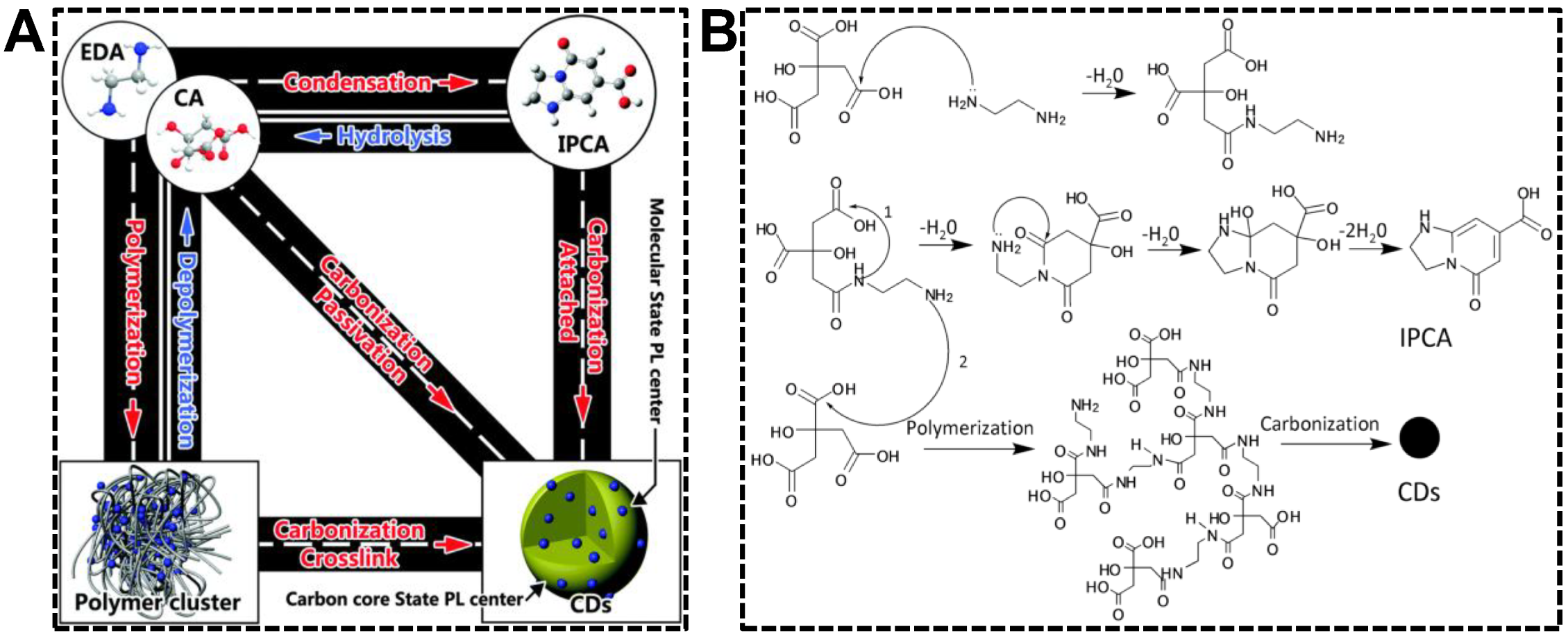

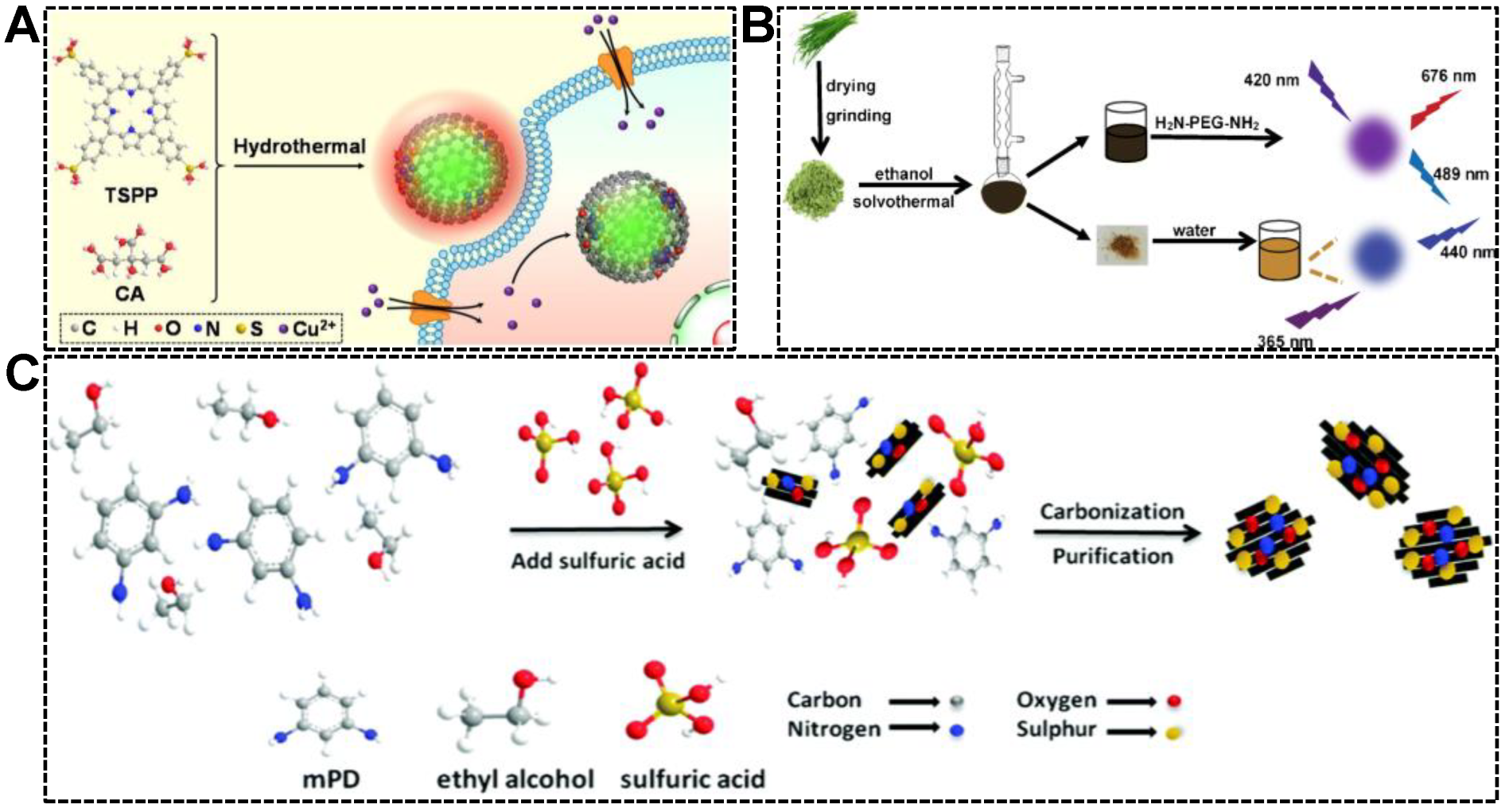
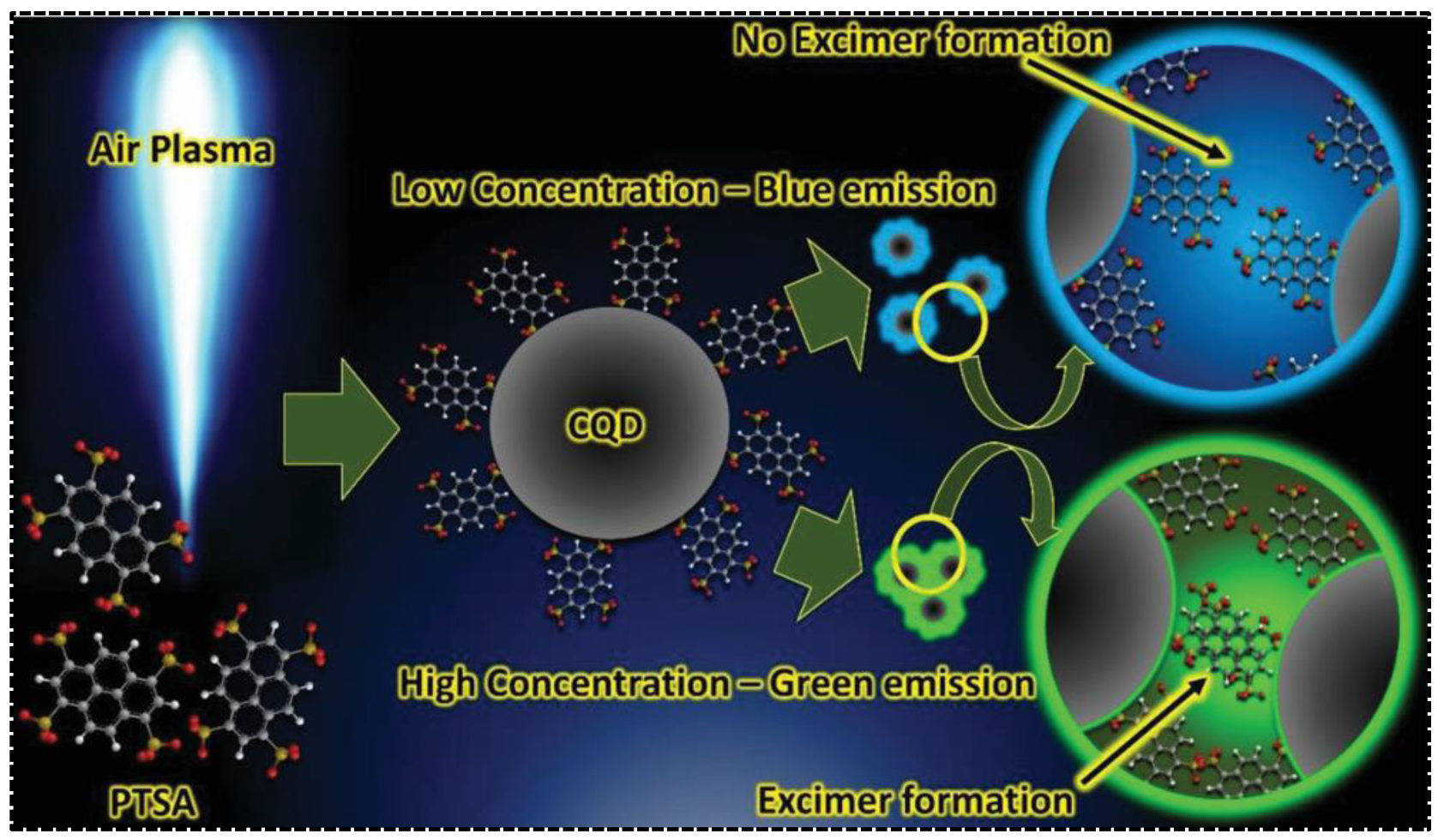


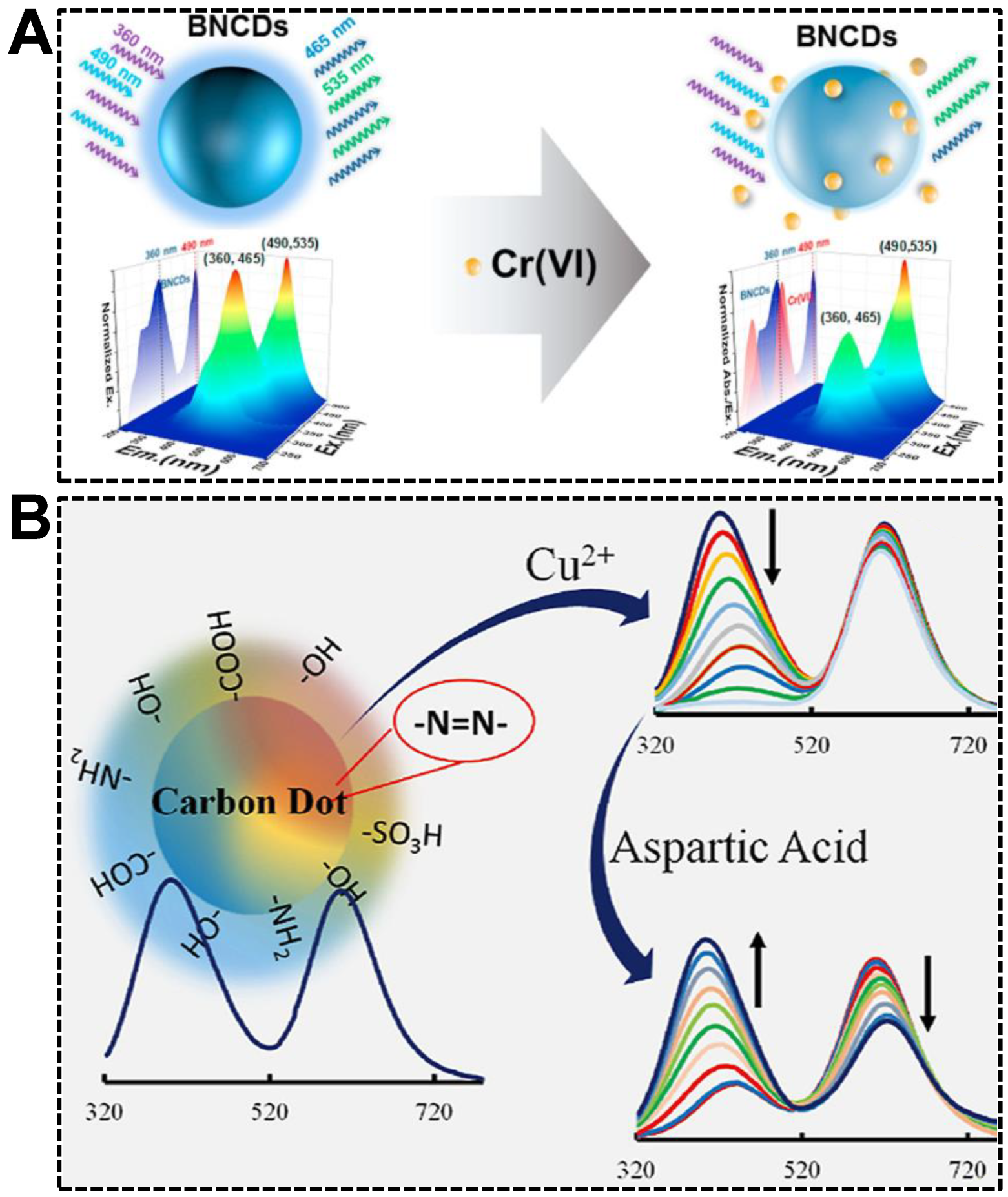
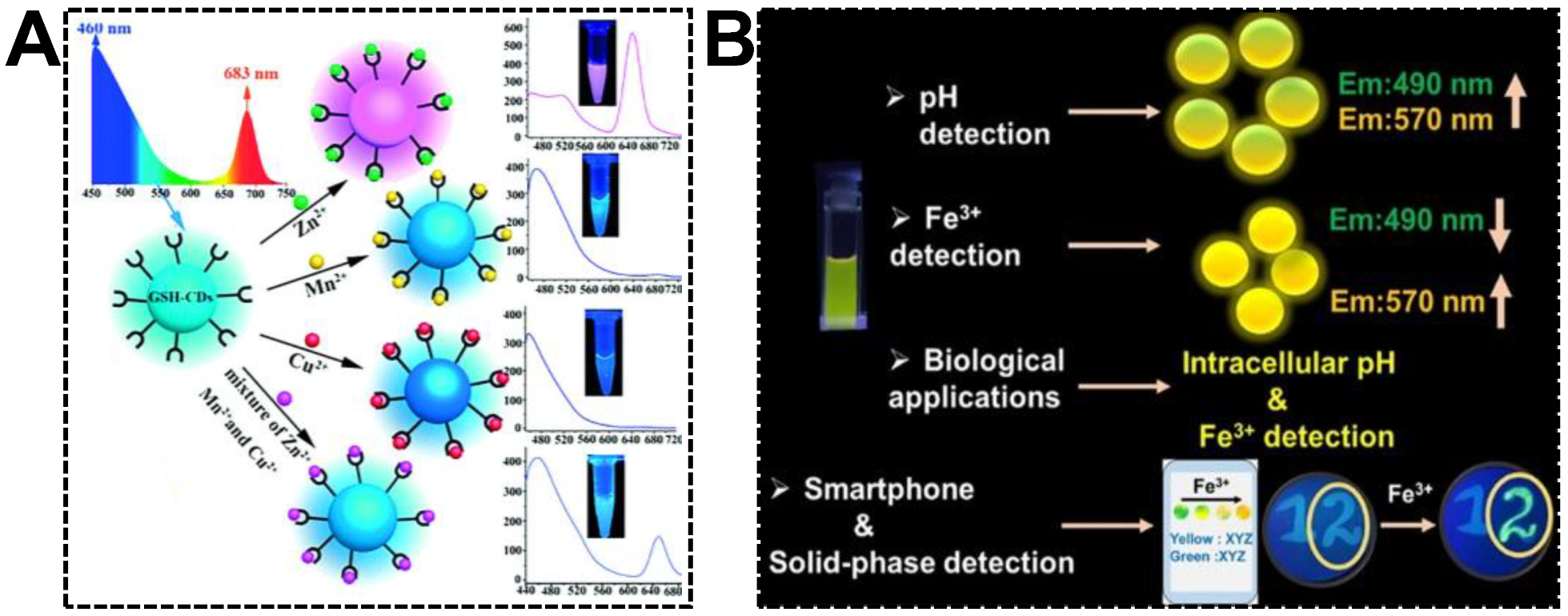

Disclaimer/Publisher’s Note: The statements, opinions and data contained in all publications are solely those of the individual author(s) and contributor(s) and not of MDPI and/or the editor(s). MDPI and/or the editor(s) disclaim responsibility for any injury to people or property resulting from any ideas, methods, instructions or products referred to in the content. |
© 2023 by the authors. Licensee MDPI, Basel, Switzerland. This article is an open access article distributed under the terms and conditions of the Creative Commons Attribution (CC BY) license (https://creativecommons.org/licenses/by/4.0/).
Share and Cite
Liu, Y.; Liang, F.; Sun, J.; Sun, R.; Liu, C.; Deng, C.; Seidi, F. Synthesis Strategies, Optical Mechanisms, and Applications of Dual-Emissive Carbon Dots. Nanomaterials 2023, 13, 2869. https://doi.org/10.3390/nano13212869
Liu Y, Liang F, Sun J, Sun R, Liu C, Deng C, Seidi F. Synthesis Strategies, Optical Mechanisms, and Applications of Dual-Emissive Carbon Dots. Nanomaterials. 2023; 13(21):2869. https://doi.org/10.3390/nano13212869
Chicago/Turabian StyleLiu, Yuqian, Fangyuan Liang, Jianglei Sun, Ran Sun, Chao Liu, Chao Deng, and Farzad Seidi. 2023. "Synthesis Strategies, Optical Mechanisms, and Applications of Dual-Emissive Carbon Dots" Nanomaterials 13, no. 21: 2869. https://doi.org/10.3390/nano13212869
APA StyleLiu, Y., Liang, F., Sun, J., Sun, R., Liu, C., Deng, C., & Seidi, F. (2023). Synthesis Strategies, Optical Mechanisms, and Applications of Dual-Emissive Carbon Dots. Nanomaterials, 13(21), 2869. https://doi.org/10.3390/nano13212869





